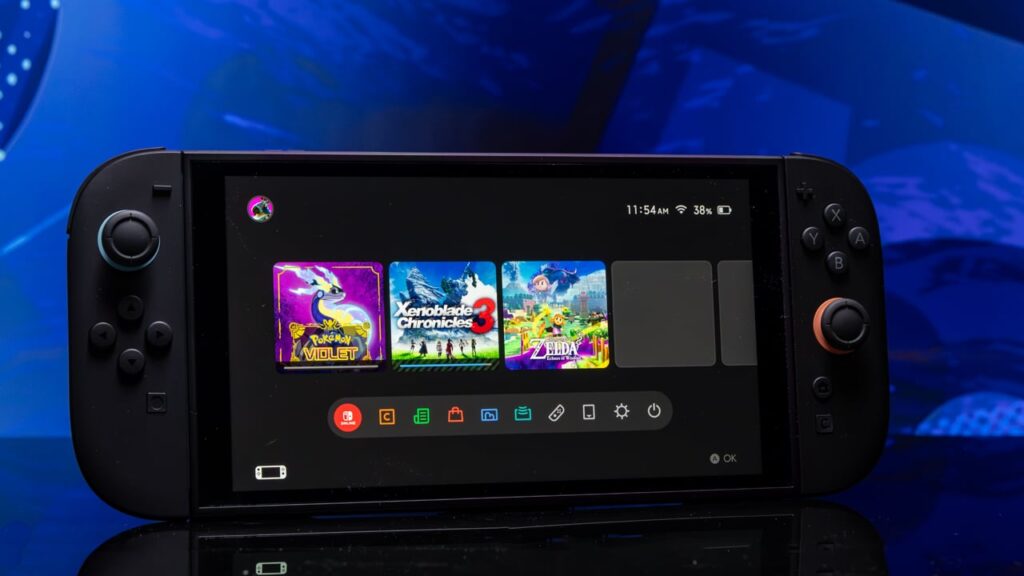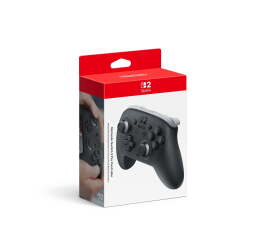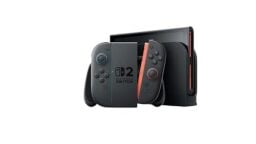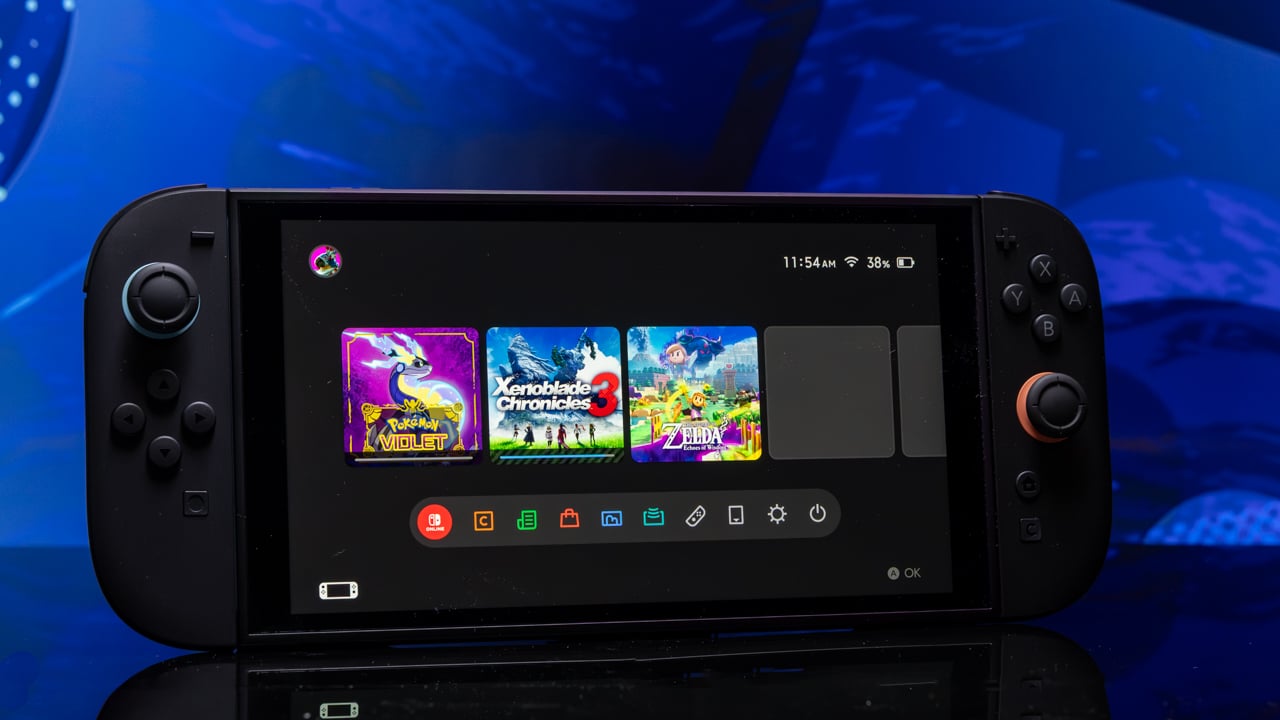
It’s been a long eight years.
Since the Nintendo Switch launched in early 2017, we’ve collectively experienced the worst pandemic in a century. Presidents have come, gone, and come back again. In our personal lives, we’ve all experienced a tremendous amount of growth and change, whether we realize it or not. And through it all, we had the Switch, arguably the best Nintendo console ever made, and one of the best game consoles of all time.
So, how do you follow that up? It turns out the answer is “make it again, but better.” The Nintendo Switch 2 launched on June 5, and it’s already my new favorite Nintendo console, purely from a hardware perspective. Switch 2 sales have also smashed Nintendo records with 3.5 million units sold in a week. The new console/handheld hybrid is a souped-up sequel with added horsepower to make games look and perform better than ever. But that’s only part of what makes it great.
Put simply, the Switch 2 is full of so many thoughtful little considerations that I’ve frequently found myself amazed at how often it just works. For much of its recent history, Nintendo hardware has been an active impediment to enjoying Nintendo software because basic things like “playing video games on the internet with your friends” were often maddeningly arcane. That’s not the case anymore…for the most part.
While there are definitely quirks with the setup process, the new virtual game cards, and the $450 price tag (not counting games and peripherals), I’m confident these problems will soften in time. I believe that eight years from now, we’ll probably talk about the Switch 2 the same way we talk about its predecessor.
Nintendo Switch 2 review: The basics

Credit: Nintendo
To start, I want to get something out of the way: I will not be analyzing the Switch 2’s lineup of launch games in this hands-on review. The way I feel about the launch titles now will be irrelevant in a month or two. I will say that Mario Kart World is a ton of fun, but if that’s not enough for you, you can wait a bit to get a Switch 2. That is all I will say on the matter.
Anyway, in case you’ve been living an ascetic off-the-grid existence for the last six months, the Switch 2 is a lot like the Switch 1. It’s a handheld game console with detachable controllers that can be placed into a dock, which then outputs the image to a television. It’s mostly compatible with Switch 1 games, and a decent number of them are actually better on Switch 2 thanks to paid upgrade packs, free patches, or, most surprisingly, the fact that the hardware inside the Switch 2 makes games better by itself, in some cases.
In other words, if you’ve been a Switch devotee for the past several years, you can pick up right where you left off without even buying any new games. That’s rad, but it’s also just following the precedent set by the PS5 and Xbox Series X five years ago, so I don’t want to give Nintendo too much praise for this. This is the bare minimum we should expect from new gaming consoles.
Before I get into discussing each granular part of Switch 2, I’d like to say it feels great in the hands. I personally like that it’s bigger than the first Switch, which eventually started to feel a bit like a child’s toy after I got used to the Steam Deck. Nintendo made the vital decision to maintain the exact same level of thinness as the first Switch, so while it has a larger surface area, it’s not anywhere near as bulky as handheld gaming PC alternatives. At 1.18 pounds, it’s noticeably heavier than the first Switch, but I wouldn’t call it burdensome to hold at all. It just feels more substantial, which I like.
The display looks good, but not OLED good
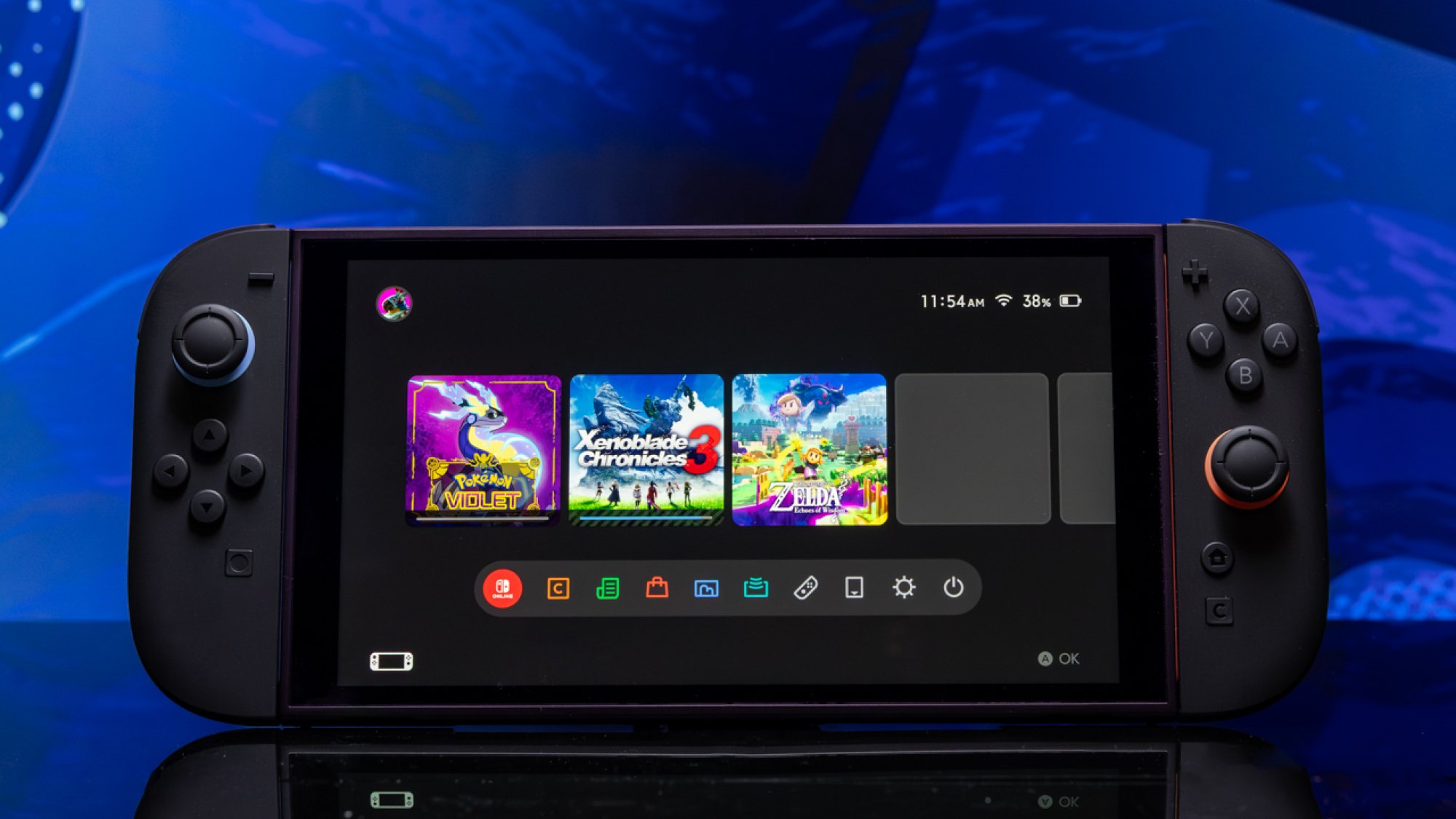
Credit: Joe Maldonado/Mashable
For some, the Switch never plugged into a TV at all. For others (like myself), it never left the dock. I largely fell out of love with handheld gaming as a teenager, as that was around the time TVs started to get really big and swanky. It didn’t help that I lived in a place with no public transit at the time, either. There just wasn’t much room for it in my life anymore. The Switch 2 display is changing that equation for me.
-
1080p resolution
-
120Hz refresh rate
-
HDR support
-
LCD panel
-
7.9 inches
For comparison’s sake, this display is about an inch bigger than the first Switch’s LCD display, which also had no HDR support, topped out at 720p, and didn’t go beyond 60Hz.
You may have noticed I didn’t say “OLED.” This is likely going to be one of the first sources of disappointment for people, especially those with a Switch OLED or Steam Deck OLED. While the Switch 2’s LCD is good, it definitely lacks the wider color range and more defined whites and blacks that an OLED offers. Games simply don’t look as vibrant as they could on the Switch 2’s display, especially if you frequently go between playing on a nice TV and playing in handheld mode.
Brightness, too, is just OK. To be clear, the positives outweigh the negatives here; it’s still a better display in terms of resolution and refresh rate than any Steam Deck model. Having a 120Hz panel is especially vital because it enables developers to include 40Hz performance modes in their games, which is a way to compromise between visual fidelity and smoothness in more demanding AAA blockbuster titles. Switch 2 games such as Cyberpunk 2077 make especially good use of this feature in handheld play.
Still, I wouldn’t blame anyone who wanted to wait for the inevitable OLED model in a year or two.
The controllers are a big upgrade
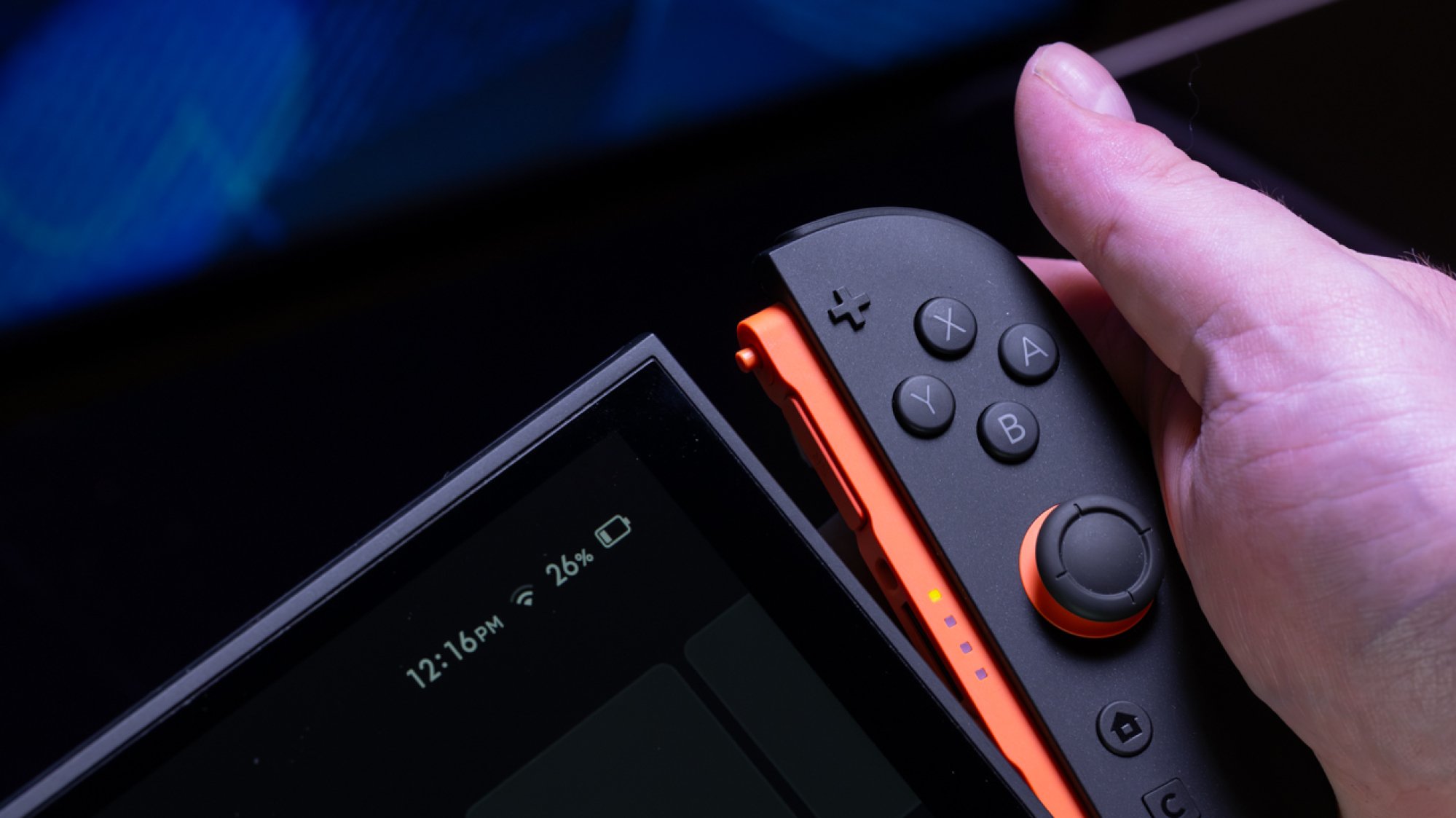
Credit: Joe Maldonado/Mashable
Just like the Switch 1, there are multiple control options with Switch 2.
The new Joy-Con 2 controllers attach and detach from the display using magnets, rather than a sliding rail mechanism, which is infinitely more satisfying. It’s also more secure thanks to a clever release lever you have to pull to detach each Joy-Con. The previous console’s Joy-Cons had a distinct little wiggle to them, even when attached, but the new ones feel locked in.
As I said in my day one Switch 2 review, attaching and detaching the new magnetic Joy-Con 2 controllers feels so good the first time you do it. Trust me.
The Switch 2 Joy Cons are also bigger, which is nice for people like me who have adult-sized hands. Admittedly, in handheld play, I still get a bit uncomfortable during long sessions. You don’t get much of a grip on either side by default, so I specifically felt my right hand cramp up to a small extent while playing in bed. I’ve heard other people complain about how the Joy-Cons feel when placed into the little grip accessory that turns them into more of a regular game controller, though I actually find that more comfortable than using them in handheld mode.
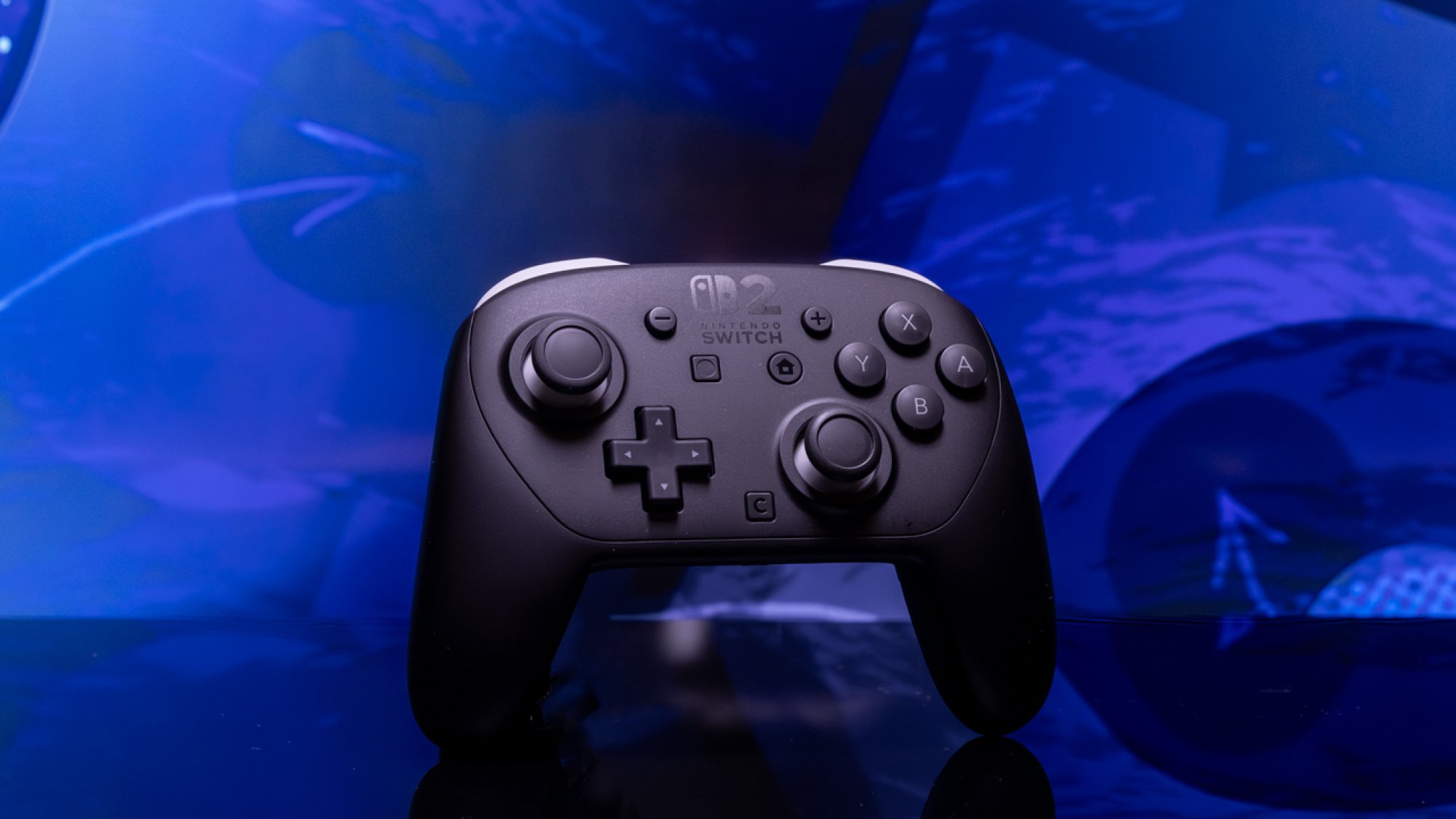
Credit: Joe Maldonado/Mashable
Minor cramping issues aside (I was able to alleviate a good deal of it by just adjusting my bodily position), the buttons are more satisfying to press, and the new analog sticks are notably more responsive. They’re very smooth in a way that’s hard to articulate without just telling you to try them. We will have to wait and see if stick drift becomes an issue over time.
Like a lot of people, I have always preferred the Pro Controller, and the new Switch 2 Pro Controller is…basically the same as the first one. That’s not a bad thing! It’s a little more dense and heavy, presumably due to improved internal mechanisms, but that’s fine. Buttons and analog sticks feel great across the board on the Pro Controller, and it brings back gyro controls for games that benefit from those, so you aren’t missing out on anything by using it. I highly recommend picking one of these up, if you can.
Going back to my earlier point about how much of the Switch 2 “just works,” this can first be seen with controllers. You can actually pair your Switch 1 Joy-Cons or Pro Controllers with a Switch 2. According to Reddit, you can even use a Switch 1 Joy-Con and a Switch 2 Joy-Con together as a pair. You don’t really have to jump through any weird hoops to make any of this happen, either. I went to a friend’s place for a Mario Kart night, and using a Switch 1 Pro Controller worked seamlessly. It’s great that your old accessories aren’t immediately useless on the new console.
The dock
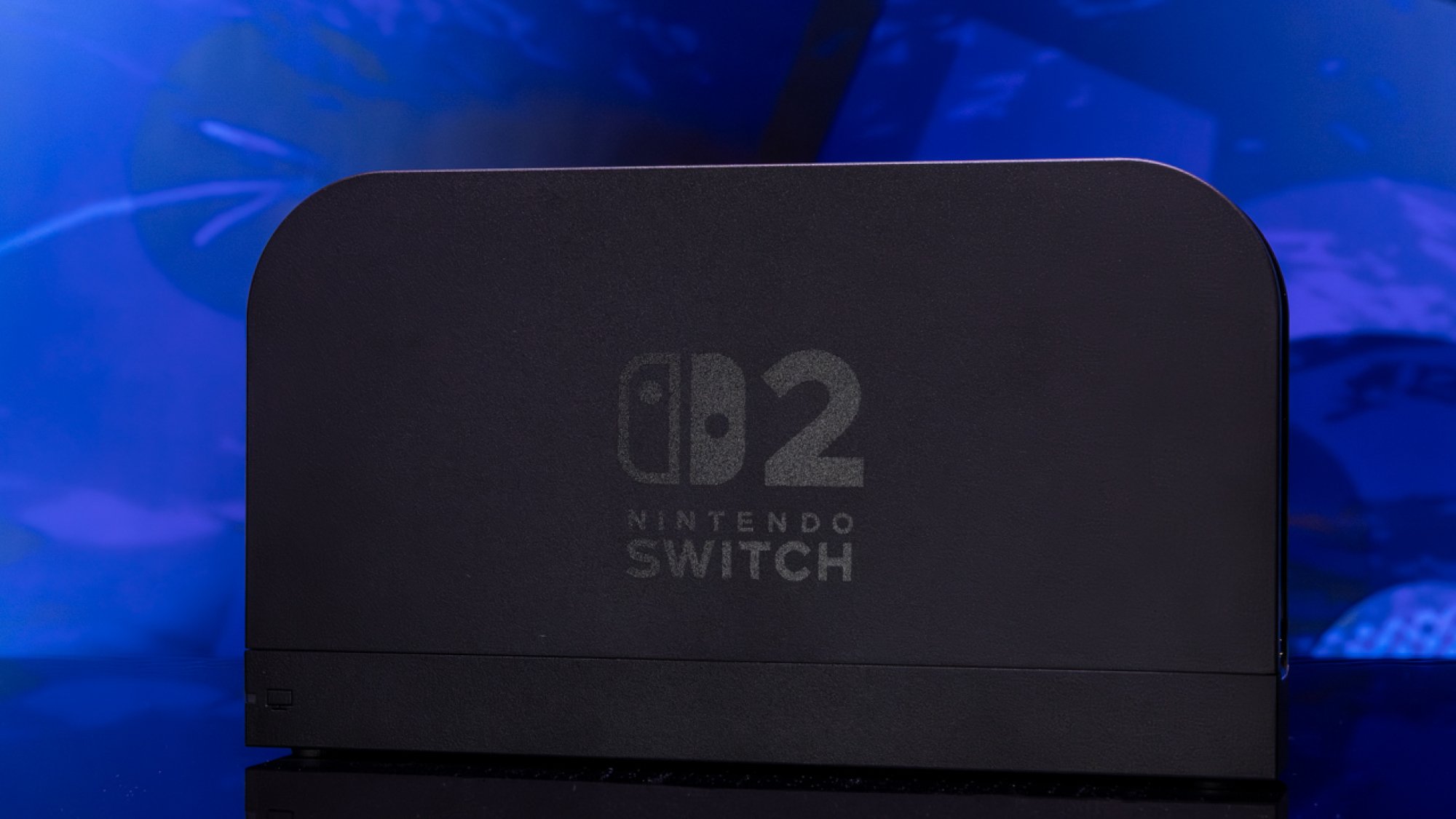
Credit: Joe Maldonado/Mashable
There isn’t a ton to say about the Switch 2’s dock because, like before, it’s meant to sit underneath or next to a TV, where ideally you’ll barely ever think about it. It’s more bulky than its predecessor thanks to some additional processing power and more fans inside of it, but it’s still smaller than your average game console by a wide margin.
Unlike the original Switch dock (and like the Switch OLED dock), there’s an included Ethernet port now. Hell yes. I wired it up to my router right away and will never change that, at least not until the Switch 3 comes around. You should do the same.
The software
From a system-level software standpoint, the Switch 2 is a lot like the Switch 1. The main menu looks more or less identical, save for some new icons on the bottom row. There are still only two themes, a light one and a dark one. Aside from a couple of amusing little sound effects here and there, it’s very sterile and lacks the pizzazz of previous Nintendo console operating systems.
There’s definitely a part of me that resents this. The UI is quick and snappy, yes, but it’s possible to marry efficiency of use with fun aesthetics. Even some fun themes would help a lot, but alas, they aren’t here.
I don’t want to paper over the “quick and snappy” part, though, especially as it relates to the new eShop. Nintendo’s digital storefronts have been nightmarishly sluggish to use for basically as long as they’ve existed, across various DS consoles, the Wii, the Wii U, and the first Switch. The new eShop isn’t flashy (or even very different at all) in appearance, but my God, does it work so much better than before. You can get in, purchase a game, and get out in less than a minute. Praise be.
The social features: GameChat is a godsend
Revisiting the theme of Switch 2’s thoughtfulness and elegance, let’s talk about its online features.
Yes, I can imagine you’re a little shocked to see the words “thoughtfulness” and “elegance” anywhere near “online features” as they relate to a Nintendo console. But nothing surprised me more about the Switch 2 than GameChat. This is a voice and video chat feature you can activate by pressing the “C” button, the only new button on every Switch 2 controller. Doing so prompts you to either start a room or join an existing one being hosted by one of your friends, and up to 12 people can be in a GameChat room at once.
Of course, this is similar to what has been on offer on Xbox and PlayStation consoles for nearly two decades. Nintendo didn’t reinvent the wheel here. What it did do, however, is create a voice chat service that moves beyond pure utility and into the realm of actively being enjoyable to use. Nintendo achieved this by placing a big priority on open-room microphone use, and everything that makes GameChat great starts from there.
There’s a mic built into the Switch 2 itself that is simply remarkable at picking up human voices and filtering out everything else. It feels like magic, especially considering a docked Switch’s microphone is usually closer to your TV speaker. I tested GameChat while sitting next to a loud window air conditioner unit, and the people on the other end swear they couldn’t hear it. Likewise, I’ve never heard anything other than their voices, either.
This also opens up more possibilities for group play, as several people can physically be in a room together and talk into the same microphone. That’s the kind of thing that headset-centric voice chat can’t do.
That said, you can also plug a headset into your Pro Controller’s new headphone jack, too. One of the most “oh my god I can’t believe that worked” moments for me was when I connected the official wireless PlayStation headset to my Switch 2, and it worked natively, with the console even correctly labeling it as a PlayStation headset. I wasn’t shocked that the audio would output to the headset (you can also do that on a Switch 1, funnily enough), but the fact that the microphone worked without any fuss whatsoever felt miraculous to me.
And if you’re a parent who’s worried about young children playing GameChat, check out the new parental controls for the Switch 2.
GameChat makes social livestreaming possible
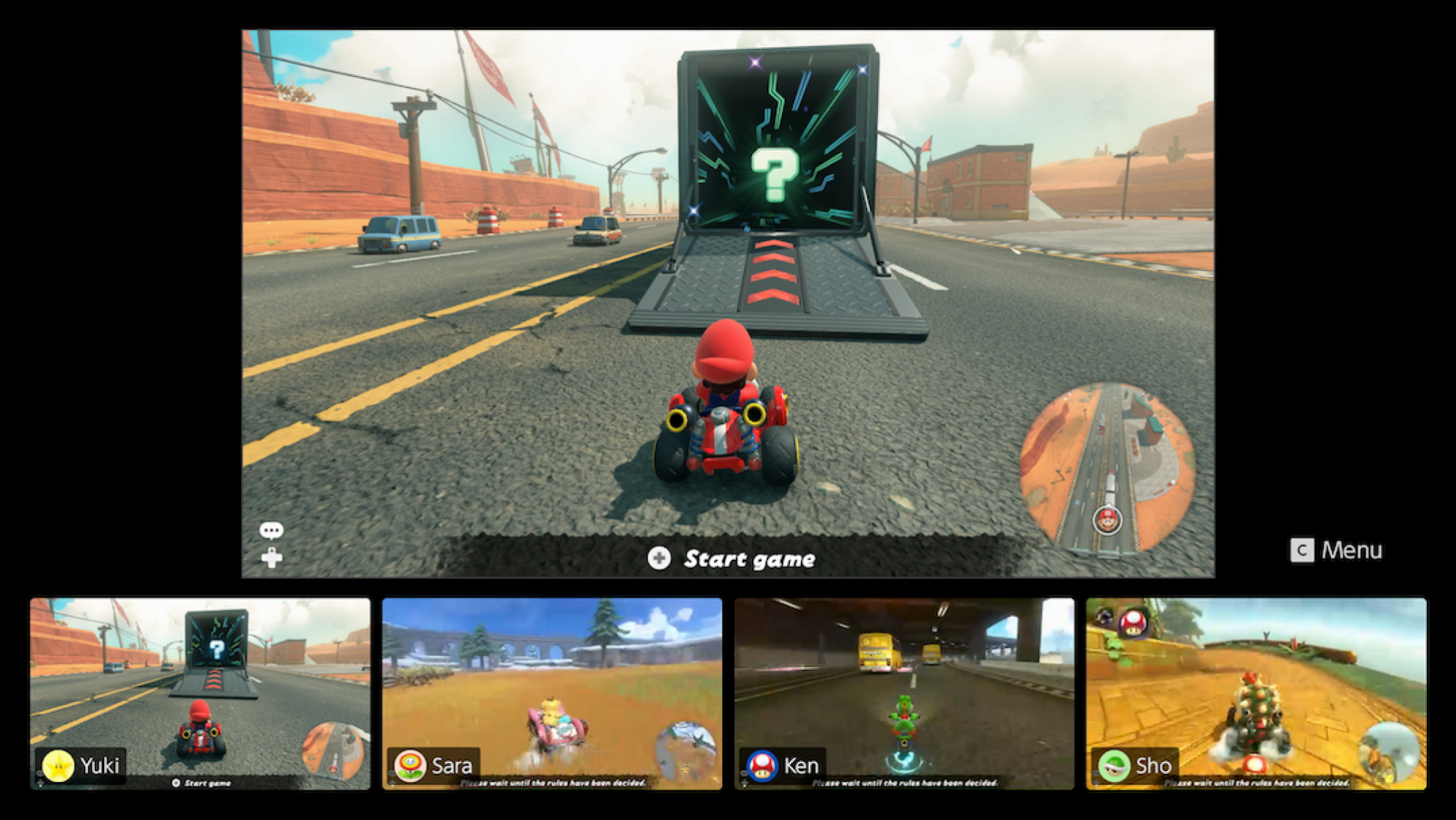
Credit: Nintendo
Unbelievably, there’s way more to GameChat than merely talking to people. Up to four people in one GameChat session can actually stream their gameplay feed to everyone else, and those feeds are arranged horizontally in a row along the bottom of the screen. You can blow up someone’s feed to full-screen to watch them play or turn off any individual user’s feed if it’s distracting to you.
Yes, of course, the feed is very choppy, running at what I estimate to be about 10 frames per second. However, the picture is clear enough to see what’s going on, at least. You don’t want to stare at one of these streams for very long, but it’s actually pretty handy (and more importantly, fun) to be able to see what your friends are doing. It even works across games. Over the weekend, my friend sold me on an indie game called Pipistrello and the Cursed Yoyo using game streaming, while I simultaneously showed them Vectorman for the Sega Genesis. We wound up spending about half an hour chatting about whatever while occasionally checking in on each other’s feeds, and it felt like I was in a Nintendo commercial.
GameChat offers webcam support
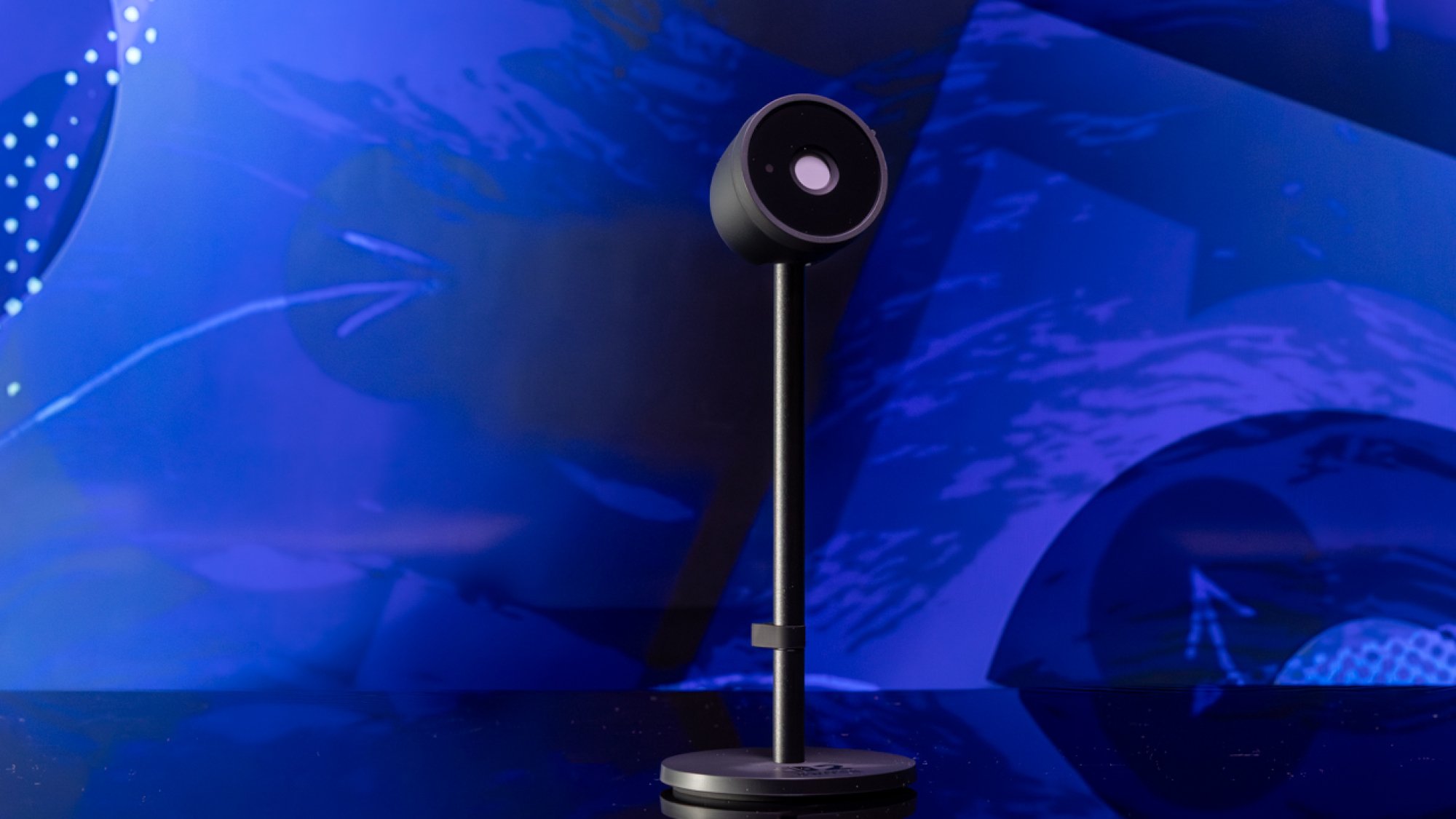
Credit: Joe Maldonado/Mashable
For my Switch 2 review, I tested out webcam support using the official Nintendo camera. Don’t worry if you don’t want to spend $54.99 on that, though, because it sounds like basically any old USB-C camera will work. By default, the camera will try to cut out your face/body from the background of your little GameChat window, though it had a hard time doing that cleanly in my limited testing. To be honest, I don’t see myself using this very much, but it’s nice that it’s there, especially for folks who use online gaming as a way to spend time with loved ones whose faces they don’t get to see that often.
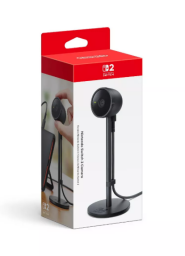
Opens in a new window
Beyond that, GameChat has a fairly incredible speech-to-text window that’s astoundingly fast and accurate. It even labels individual speakers! My favorite part is that it doesn’t censor curse words, either. Amusingly, it also properly capitalizes many brand names, even those from competing game publishers like “The Last of Us” and “Sega Dreamcast.”
And that still isn’t everything! There’s a new feature called GameShare that you can use to, well, share a game digitally with friends who are in a GameChat session with you. I tested this out with a rather fun futuristic racing game called Fast Fusion. All I had to do was create a room, send an invite to my friend, and they were almost instantly playing with me. Remarkably, they didn’t have to download anything beforehand. I’m guessing this is using some newfangled streaming tech because my friend noted that their feed was a little blurry. That said, the frame rate was apparently smooth and the game was perfectly responsive. It should be noted that it’s up to developers to support GameShare, and you can’t just do it with any game. However, I can at least confirm that it works amazingly well where it’s supported.
I don’t want to say something I can’t take back like “Nintendo has finally figured out the internet,” but…maybe Nintendo has finally figured out the internet? I will say this: I love GameChat.
The hidden costs and headaches

Credit: Joe Maldonado/Mashable
I’ve been effusively praising the Switch 2 for most of this review, but because this is still a Nintendo console at the end of the day, there are a handful of very irritating things about it.
Most unexpected of all is pricing. I maintain that $450 for the console, while not inexpensive, is reasonable given its technical specs. It’s the accessories and other accoutrements that get out of control, partially due to President Trump’s tariff policies, according to Nintendo.
The camera is $54.99. A pair of new Joy-Cons is $94.99. A Pro Controller is $84.99. And Mario Kart World, the console’s lone flagship launch title, is $79.99, which really stings, even if someone was going to do that eventually. There are plenty of reasons why video game prices have gotten so high, but all the context in the world doesn’t matter when that charge hits your bank account.
Switch 2’s internal storage capacity of 256GB is also problematic because the only way to expand the storage is to buy a microSD Express card. That’s a relatively new kind of external storage that most regular people probably don’t know about and isn’t always super clearly labeled when you go to buy a microSD card. For context, microSD Express has substantially faster data read speeds than the regular microSD card you used in your Switch 1, which I feel the need to emphasize will not work in your Switch 2.
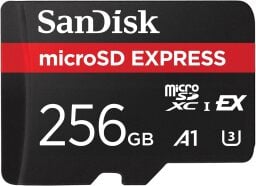
Opens in a new window
If Nintendo allowed the use of normal microSD cards, the Switch 2 would be a less capable machine. Unfortunately, given that we’re probably at least a year or two away from microSD Express cards being more affordable, we’re in this awkward period where the Switch 2 is future-proofed, but not necessarily present-proofed. It doesn’t help that a few launch games, namely Cyberpunk 2077 and Hitman approach 60GB install sizes.
Speaking of digital game installs, Nintendo has introduced a new “virtual game card” system for tying digital purchases to a user’s account. If you download a game from the store, it gets “loaded” onto your console, where it will live exclusively until you delete it, load it onto a different Switch console, or virtually loan it to a friend for up to two weeks. Just so I’m being perfectly clear: If you loan a virtual game card to someone, you can’t play that game you bought until it’s returned to you.
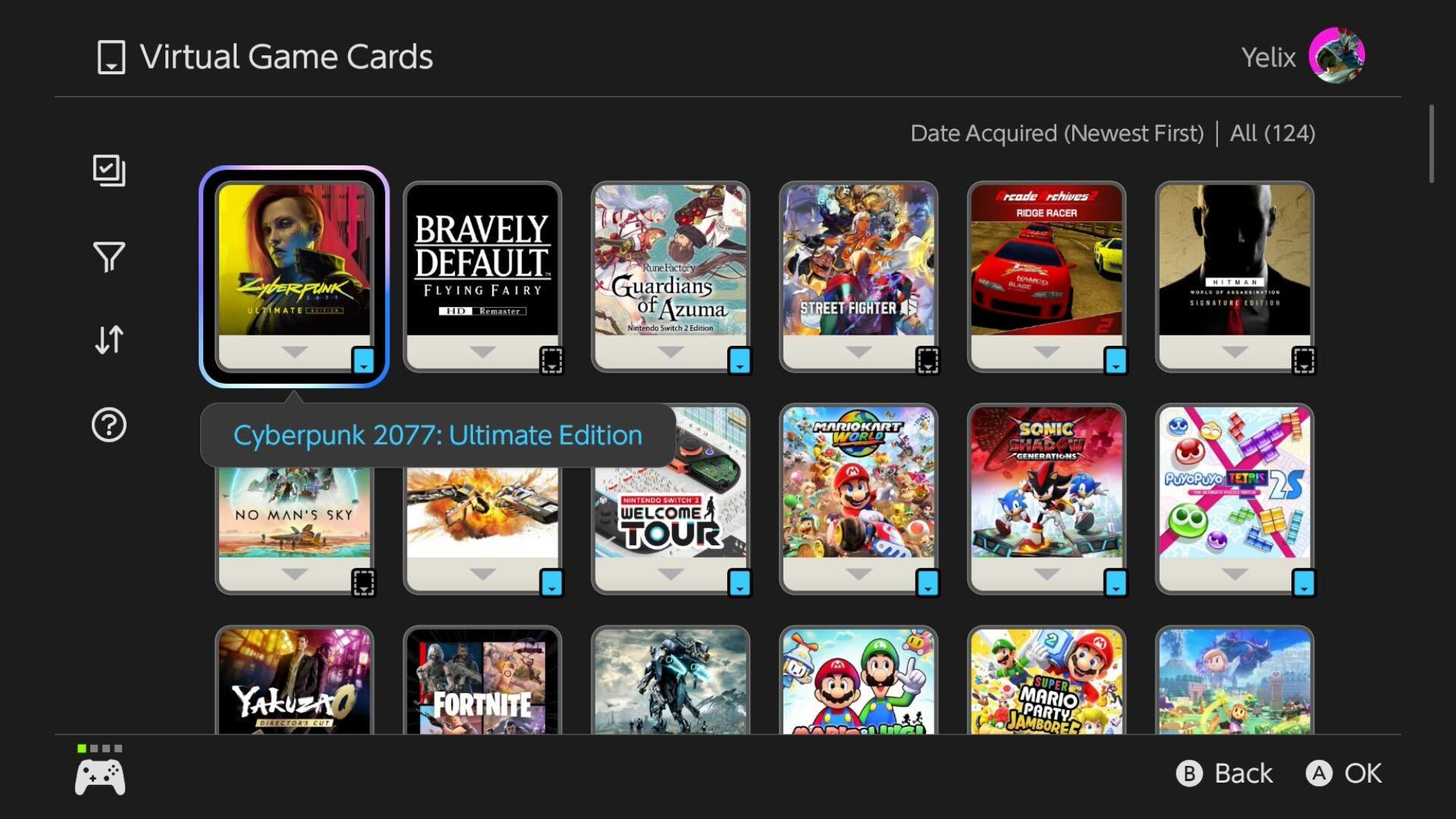
Credit: Screenshot: Nintendo
For childless people like me, this is an arcane nuisance that’s easy enough to overlook. For anyone who lives in a multi-Switch household (and there are a lot of those), this could be a logistical nightmare for competitive siblings. I shudder to think about the inevitable fights over who gets to have the Mario Kart virtual game card for the next two weeks. Godspeed, parents.
The last (and to be honest, least) of these problems regards the initial setup process for Switch 2. Most of it is standard stuff: connect to WiFi, log into your account, set the time zone, etc. On top of that, you’ll also be given the opportunity to transfer data from a Switch 1 to your new Switch 2, which, again, is normal and fine. What’s not normal and fine is that apparently you only get one shot to do this, so if you say no out of expediency, that’s it.
Animal Crossing: New Horizons and Pokémon: Scarlet and Violet players need to take note of this because those are two of the only major Switch 1 games that don’t allow for the use of cloud saves. If you don’t transfer your save data from a Switch 1, you will have to start over. I really hope Nintendo fixes this and allows for post-setup data transfers soon.
The Switch 2 battery life
Oh yeah, the Switch 2 is a handheld console, so battery life is worth examining. Nintendo rates the console’s battery life at two to 6.5 hours. My testing has been far from scientific (I’ll update this hands-on review after spending more time with the console), but I haven’t been able to get more than three or so hours out of a full charge. We knew ahead of time that it would have a worse battery life than Switch 1, so this isn’t some huge rug-pull or anything.
Your mileage may vary depending on the games you play. An old Switch 1 game that doesn’t make use of any advanced Switch 2 hardware features will probably get more juice out of a full charge than Cyberpunk 2077, which just annihilates the battery in an almost impressive fashion. It definitely sucks for a product to have a worse battery life than its predecessor, but in fairness, it’s not very different from any other modern gaming handheld. They’ve all sacrificed longevity for power.
The verdict: I can’t stop playing my Switch 2
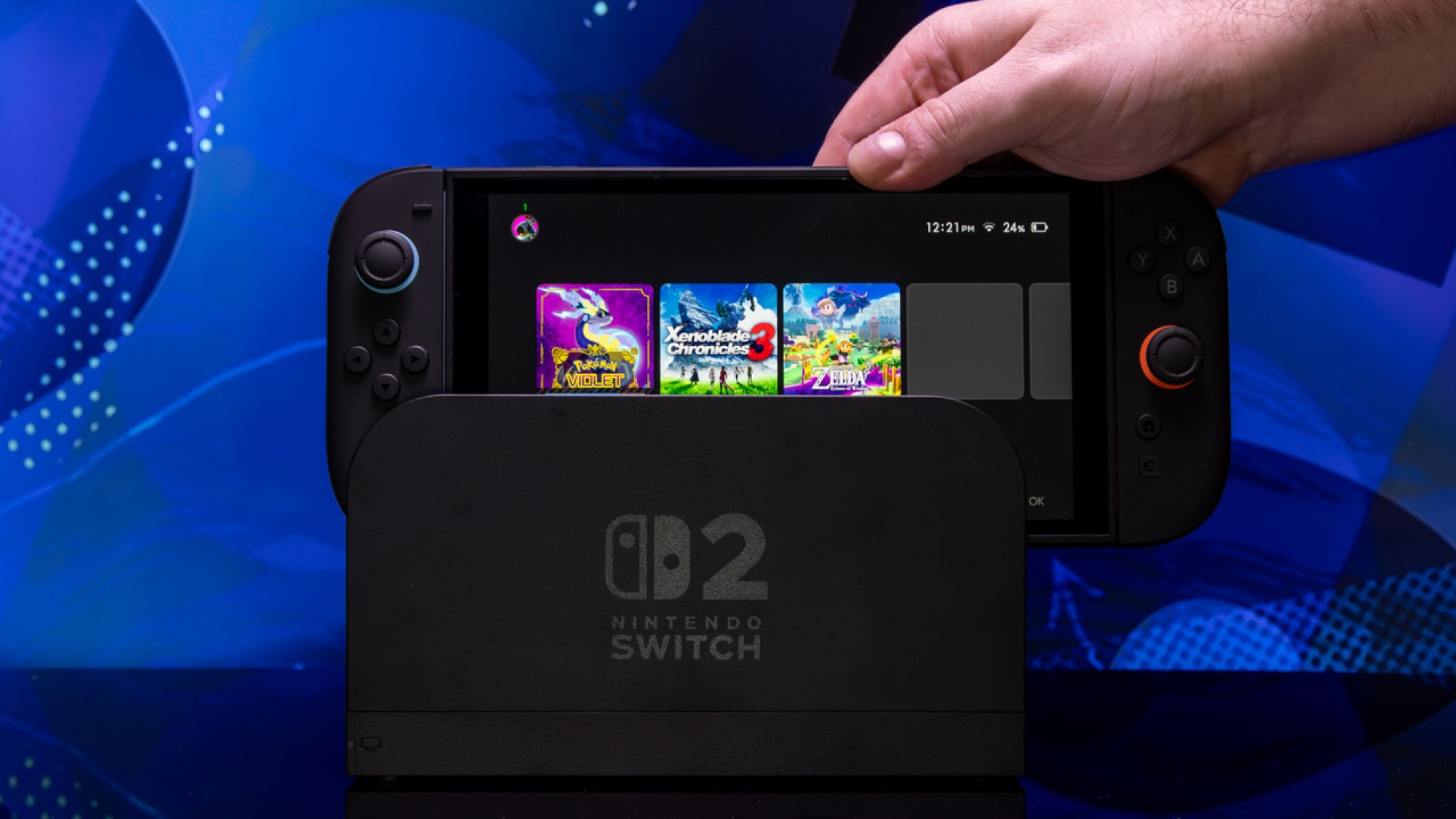
Credit: Joe Maldonado/Mashable
I’m going to keep this short because I just spent more than 3,500 words explaining my thoughts: The Nintendo Switch 2 is great. This is a fabulous console/handheld hybrid with hugely improved system software, much beefier horsepower for playing games, and a more premium form factor that doesn’t succumb to the same bulk as its handheld PC counterparts.
Sure, the Switch 2 isn’t without some hangups. Pricing will continue to be a topic of conversation. I’m also nervous about future price hikes, in light of Xbox recently doing that in the middle of a console generation. The virtual game card system also feels like it will create more problems than it solves, and Switch 2 owners are going to have to get stingy with storage space until microSD Express cards become cheaper.
But all of that is lessened in my mind because I know Nintendo’s first-party games for the new Switch console will largely be excellent, and its capacity for third-party support is greatly expanded. Switch 2’s online social features could also be legitimately game-changing for Nintendo, a company that is finally willing to acknowledge that not everyone can or wants to play multiplayer games locally.
At any rate, I think the next seven or eight years of Nintendo will be just fine.
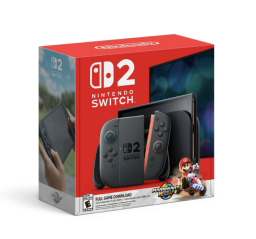
Opens in a new window

